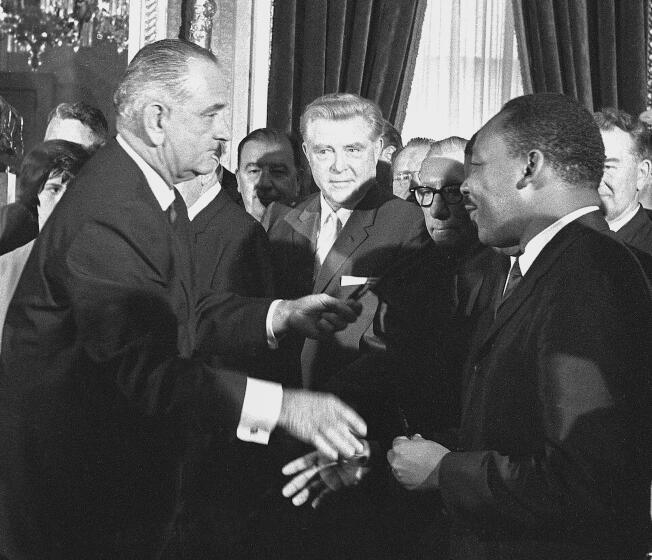Opinion: The outlandish ruling that could eviscerate what's left of the landmark Voting Rights Act

- Oops!Something went wrong.Please try again later.
- Oops!Something went wrong.Please try again later.
If a decision handed down by a conservative federal appeals court last week is allowed to stand, it will gut what remains of one of the most important federal laws enacted in my lifetime, the Voting Rights Act.
An 8th Circuit Court of Appeals panel held that no one other than the federal government can sue to enforce a key section of this vital statute. And as the dissenting judge pointed out, only 15 of the 182 successful suits under the section over the last 40 years were brought solely by the Department of Justice.
The Voting Rights Act has been remarkably effective in countering the myriad laws and practices the Southern states adopted to keep Black people from voting since the end of Reconstruction. Turnout among Black voters in Mississippi increased from 6% in 1964, the year before the law was enacted, to 59% in 1969.
Read more: Opinion: Why today's Supreme Court decision on voting rights is such a shock
Section 2 of the Voting Rights Act prohibits state and local election practices and systems from discriminating against voters of color. Congress strengthened the provision in 1982 so that proof of intentional discrimination would no longer be necessary; it’s sufficient to show discriminatory impact.
Even under the conservative Roberts court, Section 2 has provided crucial protection against race discrimination in voting. This year, for example, in Allen vs. Milligan, the court found that Alabama had violated the Voting Rights Act in drawing congressional districts.
Alabama’s population is 27% Black, but the state’s Legislature had drawn the congressional districts so that only one of six had a Black majority. The court’s ruling that the districts violated Section 2 led to a new map with two majority-Black districts.
Read more: Opinion: The Supreme Court finally has a code of ethics, but it has a fatal flaw
Under the 8th Circuit’s 2-1 ruling, however, private individuals and groups such as the ACLU and the NAACP Legal Defense Fund could not sue to enforce Section 2. Hundreds of such suits have been brought, and many have been adjudicated by the Supreme Court — among them Allen vs. Milligan — without being questioned on these grounds.
This latest threat to the Voting Rights Act comes a decade after the Supreme Court overruled another key aspect of the law, Section 5. Under that section, jurisdictions with a history of race discrimination in voting had to secure the U.S. attorney general’s approval before making significant changes to their election systems.
The court declared this “preclearance” requirement unconstitutional in 2013, ruling 5 to 4 that it violated the principle of “equal state sovereignty” to single out Southern states for the restriction. States such as North Carolina and Texas responded by quickly instituting discriminatory election practices that were previously blocked.
The latest case arose in 2021, when the Arkansas NAACP and others challenged new state House districts. The plaintiffs alleged that the Arkansas map diluted Black voting strength in violation of Section 2 and that five additional majority-Black districts should be drawn to fairly represent the state’s Black population.
The majority opinion by 8th Circuit Court Judge David Stras, a Trump appointee, concludes that only the United States government can bring such suits, contradicting 58 years of practice since the Voting Rights Act became law. Supreme Court Justice Clarence Thomas, whom Stras clerked for, raised this possibility in his Milligan dissent, but the prospect of such a radical change in the law wasn’t taken seriously by many. In fact, none of the parties in the Arkansas litigation even raised the issue: The U.S. District Court where the case was first heard improperly raised the issue on its own.
At best, the Justice Department has the resources to bring only a handful of Section 2 lawsuits a year. At worst, especially under a conservative administration, it may bring none.
In his dissent from the appeals court’s decision, Chief Judge Lavenski Smith rightly described the ruling as threatening major upheaval. “Rights so foundational to self-government and citizenship,” he wrote, “should not depend solely on the discretion or availability of the government’s agents for protection.”
As Smith noted, the Supreme Court declared more than two centuries ago, in Marbury vs. Madison, that where there is a violation of a right, there must be a remedy. If the Supreme Court doesn’t reverse the 8th Circuit’s decision, it will leave little remedy for violations of one of our most important rights.
Erwin Chemerinsky is a contributing writer to Opinion and the dean of the UC Berkeley School of Law. His latest book is “Worse Than Nothing: The Dangerous Fallacy of Originalism.”
This story originally appeared in Los Angeles Times.

